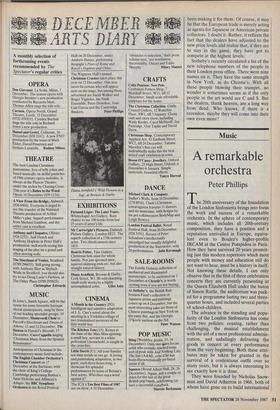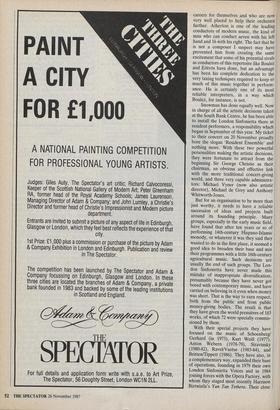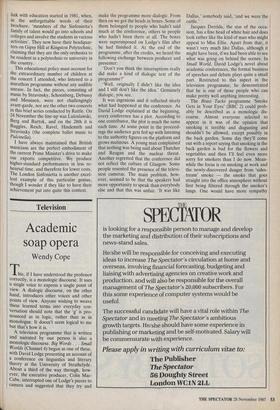Music
A remarkable orchestra
Peter Phillips
The 20th anniversary of the foundation of the London Sinfonietta brings into focus the work and success of a remarkable orchestra. In the sphere of contemporary music, which includes all 20th-century composition, they have a position and a reputation unrivalled in Europe, equiva- lent even to Boulez's higher-profile IRCAM at the Centre Pompidou in Paris. How they have survived 20 years promot- ing just this modern repertoire which most people with money and education still do not want to hear, must be a history in itself. Not knowing these details, I can only observe that in the first of three celebration concerts they are currently presenting at the Queen Elizabeth Hall under the baton of Simon Rattle, the auditorium was pack- ed for a programme lasting two and three- quarter hours, and included several parties of school-children.
The advance in the standing and popu- larity of the London Sinfonietta has come from two policies: coaxing, rather than challenging, the musical establishment with the aid of a most professional adminis- tration, and unfailingly delivering the goods in concert at every performance from the very beginning. Both these attri- butes may be taken for granted in the survival of a contentious outfit over so many years, but it is always interesting to see exactly how it is done.
They were founded by Nicholas Snow- man and David Atherton in 1968, both of whom have gone on to build international careers for themselves and who are now very well placed to help their orchestra further. Atherton is one of the leading conductors of modern music, the kind of man who can conduct seven with his left hand and 16 with his right. The fact that he is not a composer I suspect may have prevented him from creating the same excitement that some of his potential rivals as conductors of this repertoire like Boulez and EdfitvOs have done, but an advantage has been his complete dedication to the very taxing techniques required to keep so much of this music together in perform- ance. He is certainly one of its most reliable interpreters, in a way which Boulez, for instance, is not.
Snowman has done equally well. Now in charge of all the artistic decisions taken at the South Bank Centre, he has been able to install the London Sinfonietta there as resident performers, a responsibility which began in September of this year. My ticket to their concert on 20 November proudly bore the slogan `Resident Ensemble' and nothing more. With these two powerful personalities making the artistic decisions, they were fortunate to attract from the beginning Sir George Christie as their chairman, an obvious and effective link with the more traditional concert-giving world, and three very capable administra- tors: Michael Vyner (now also artistic director), Michael de Grey and Anthony Whitworth-Jones.
But for an organisation to be more than just worthy, it needs to have a reliable succession of ideas and projects built around its founding principle. Many groups, especially in the early music field, have found that after ten years or so of performing 14th-century Hispano-Islamic monody, or whatever it was they said they wanted to do in the first place, it seemed a good idea to broaden their base and mix their programmes with a little 16th-century agricultural music. Such decisions are usually the end of such groups. The Lon- don Sinfonietta. have never made this mistake of inappropriate diversification, presumably because they have never got bored with contemporary music, and have carried on believing in it even when money was short. That is the way to earn respect, both from the public and from public money-giving bodies. The result is that they have given the world premieres of 183 works, of which 72 were specially commis- sioned by them.
With their special projects they have focused on the music of Schoenberg/ Gerhard (in 1973), Kurt Weill (1977), Anton Webern (1978-79), Stravinsky (1980-82), Ravel/Varese (1983-84), and Britten/Tippett (1986). They have also, in a complementary way, expanded their base of operations, founding in 1979 their own London Sinfonietta Voices and in 1984 joining forces with the Opera Factory, with whom they staged most recently Harrison Birtwistle's Yan Tan Tethera. Their close
link with education started in 1981, when, in the unforgettable words of their brochure, 'members of the Sinfonietta's family of talent would go into schools and colleges and involve the students in various activities'. They now have their headquar- ters on Gipsy Hill at Kingston Polytechnic, claiming that they are the only orchestra to be resident in a polytechnic or university in the country.
This educational policy must account for the extraordinary number of children at the concert I attended, who listened to a marathon programme without any audible unease. In fact, the pieces, consisting of music by Stravinsky, Schoenberg, Debussy and Messiaen, were not challengingly avant-garde, nor are the other two concerts in this brief series conducted by Rattle. On 24 November the line-up was Lutoslawski, Berg and Bartok, and on the 28th it is Ruggles, Reich, Ravel, Hindemith and Stravinsky (the complete ballet music to Pulcinella).
I have always maintained that British musicians are the perfect embodiment of the current Prime Minister's drive to make our exports competitive. We produce higher-standard performances in less re- hearsal time, and therefore for lower costs. The London Sinfonietta is another excel- lent example of this particular genius, though I wonder if they like to have their achievement put into quite this context.




































































 Previous page
Previous page